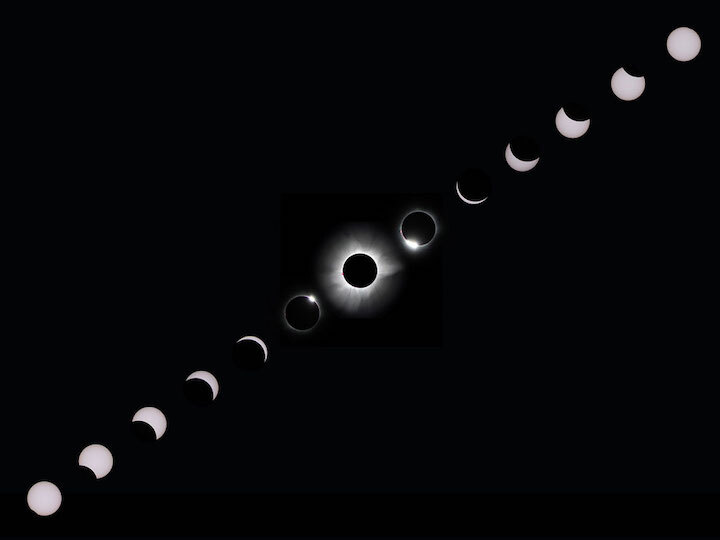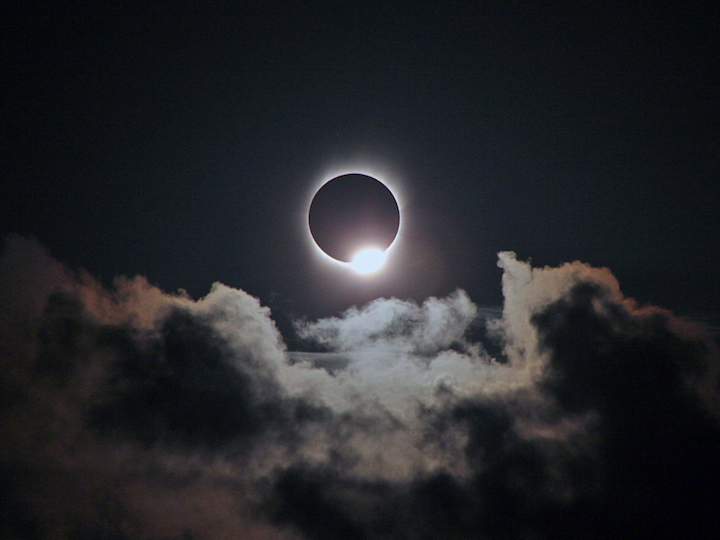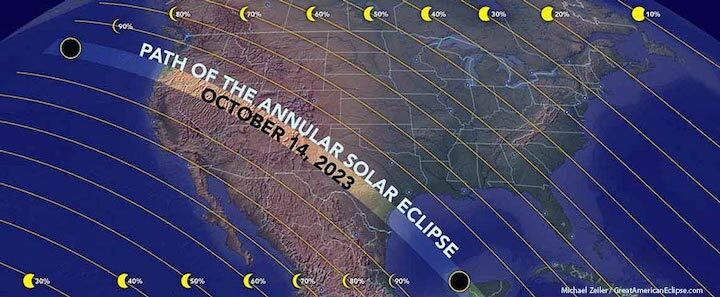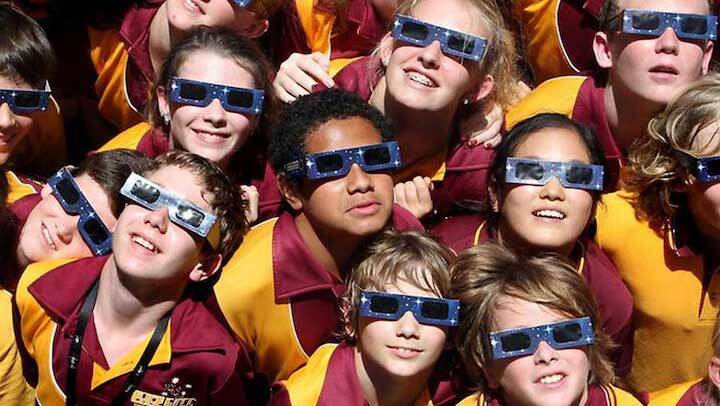11.04.2022
It’s never too early to start getting excited — or planning — for an event as spectacular as a total solar eclipse.

A total solar eclipse goes through several phases. First contact is when the Moon's leading edge begins to take a bite out of the solar disk. The total phase begins when the Moon fully covers the Sun's face and you can see bright stars, planets, and the solar corona. Eventually, the Moon pulls away and the Sun again shines unimpeded in our sky. Rick Fienberg / TravelQuest International / Wilderness Travel
If you’ve witnessed a total eclipse of the Sun, you already know that when the next one rolls around on April 8, 2024, North America will be in for a real treat. That’s when the Moon will blot out our nearest star for lucky viewers along a narrow strip of land that stretches from central Mexico, across Texas, up through New England, and into the Canadian Maritimes. Tens of millions more will see a partial eclipse, provided skies are clear.
CELESTIAL SERENDIPITY
Solar eclipses happen thanks to a fortuitous coincidence: The apparent size of the Moon is very close to that of the Sun. So when the Sun, Moon, and Earth are perfectly lined up — in what’s known as syzygy (great word for you Scrabble players out there) — the silhouette of the Moon crosses the solar disk.
When the Moon covers the disk completely, we witness a total solar eclipse. If the Moon is at apogee, or the farthest point in its orbit around Earth, then its apparent size is smaller and it won’t fully cover the solar disk. The result is a thin ring of sunshine, an annulus, rimming the edge of the blackened Moon. A partial eclipse happens when the Moon blocks only part of the disk.

Just before totality, you should see a "diamond ring" — this is sunlight peeping through a deep valley on the Moon's edge. Another diamond will appear on the opposite side of the Moon signaling the end of totality. In between, you'll get to admire the spectacular corona.Rick Fienberg / TravelQuest International /Wilderness Travel
During a total eclipse, when the Moon hides the brilliant Sun from us, you can revel in the glory of its corona, or its blistering, rarefied outer atmosphere. Temperatures reach about a million degrees here, and the ethereal filaments can extend into space for some 5 million miles. If you’ve been lucky enough to witness the corona during an eclipse, chances are you’re hooked and are constantly on the lookout for the next opportunity. If you haven’t, you’re in for a treat.
Which brings us back to April 8, 2024. That’s when the cosmic solar-lunar-terrestrial rumba brings the next total eclipse to North America. The width of the Moon’s shadow that’ll whip over Earth is around 115 miles wide. So if you find yourself inside that path, you’ll see a total eclipse (provided skies are clear, of course!).
What’s more, the Moon will blot the Sun’s light for a respectable 4 minutes 28 seconds (depending on where you are; it’s more fleeting in some locations). For comparison, the total phase of the August 2017 eclipse lasted only about 2 to 2½ minutes.

If you live within the path of totality that stretches from Mexico up through the Northeast and into Canada, you're very lucky! For those who are outside this strip of land and who can't travel to it, you'll nevertheless get to witness a partial solar eclipse. The percentages at the top and bottom of the map indicate what proportion of the solar disk will be covered by the Moon.Michael Zeiler / GreatAmericanEclipse.com
BUT THAT’S NOT ALL

During an annular eclipse, the Moon doesn't quite cover the whole of the solar disk.
Stefan Seip
Almost exactly half a year prior, on October 14, 2023, an annular solar eclipse will delight viewers along an arc from southern Oregon through southern Texas, then across the Gulf of Mexico and over the Yucatán Peninsula. For those of you in the 125-mile-wide path, you’ll see a “ring of fire” for up to 5 minutes.
Take a close look at the two maps above and below — you'll notice that they intersect somewhere around the San Antonio, Texas, area. If you live in that part of the country, you’re in for a double delight!

North America will be treated to an annular eclipse some six months before the big total. Annulars, even if less spectacular than total eclipses, are nevertheless quite the sight.Michael Zeiler / GreatAmericanEclipse.com
READY, SET, APRIL 8TH HERE WE COME
It might be two years away, but it's never too early to start planning. You’ll want to think carefully of where you want to be on the path of totality, how to get there, and also how to get out of there. (If you were among those who got stuck in frustrating traffic jams after the August 2017 eclipse, you know too well the desire not to repeat that experience!)
The American Astronomical Society has established a Solar Eclipse Task Force to ensure that things run smoothly in 2024 (and 2023), so that eager eclipse-viewers across the U.S., Canada, and Mexico can fully — and safely — take in the experience of a lifetime. As the big date approaches, the AAS will continuously update the Task Force’s eclipse website with practical information.
By the way, if you’re into eclipses and have an organizational bent, are associated with local government, or are an amateur astronomer active in your community, you may want to consider applying to serve on one of the AAS Solar Eclipse Task Force Working Groups to get involved in the action from the outset.
For more information on eclipse events local to you, check in with your local library or amateur-astronomy club. Another excellent source of information about totality in 2024 is Dan McGlaun’s comprehensive and helpful website: eclipse2024.org.

Don't ever look directly at the Sun without proper eye protection. But with appropriate glasses, you can gaze as long as you want. Just remember to remove the glasses for totality. Mark Margolis / Rainbow Symphony
One last thing: Don’t ever look directly at the Sun. We can’t stress this enough. Make sure you get proper eclipse glasses for yourself or filters for your telescope. Regular sunglasses just won’t cut it. Also, be aware of inferior or unapproved eclipse glasses — only get those with an official stamp of approval. If you have eclipse glasses lying around the house, do inspect them very carefully for scratches and tears before you use them. Read more here on the all-important issue of protecting your eyes.
This is going to be a nationwide event, and everybody’s already super-excited. Now, we just need is to make our plans and hope the weather cooperates. Fingers crossed!
Quelle: Sky&Telescope
